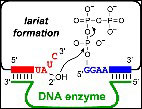Chemists create unusual lariat RNA, a key intermediate in biological splicing

Chemical reaction catalyzed by a DNA enzyme that creates lariat RNA. <br>
The production of lariat RNAs is a key step in the biologically important process of splicing. Because splicing changes the protein that is made from a given gene, a fundamental understanding of splicing is critical for comprehending the connections between genes and proteins. The study of splicing, however, has been very difficult in part because lariat RNAs have been nearly impossible to make artificially.
Now, chemistry professor Scott K. Silverman and graduate student Yangming Wang at the University of Illinois at Urbana-Champaign have found artificial deoxyribozymes (DNA enzymes) that synthesize branched and lariat RNAs. The researchers report their discovery in a paper that has been accepted for publication in the Journal of the American Chemical Society, and posted on its Web site
“Lariat RNAs are crucial intermediates in the biological splicing of messenger RNAs,” Silverman said. “The lariat RNAs synthesized by our new DNA enzymes should help provide a detailed biochemical understanding of RNA splicing.”
Lariat RNAs have an unusual connectivity in which a key “branch site” nucleotide is the meeting point between three RNA strands, two of which connect to form a loop, Silverman said. “The resulting molecule, which resembles a lariat, has the same connectivity as introns (intervening regions that don’t perform coding functions) that are removed from messenger RNAs during biological splicing in fungi, eukaryotes, and even some bacteria.”
Silverman and Wang used a process called in vitro selection to sample billions of DNA sequences for the desired chemical selectivity. The DNA enzymes the researchers found can catalyze branched RNA formation at rates up to 5 million times faster than the reaction would occur in the absence of the enzyme.
“The ability to make these branches and lariats offers us a new path for the biochemical investigation of RNA splicing,” Silverman said. “Errors in making proteins have been linked to certain diseases and birth defects, for example. By incorporating chemical modifications into these key structural intermediates, we can more thoroughly examine the fundamental splicing process.”
###
The March of Dimes, National Institutes of Health, Petroleum Research Fund and the University of Illinois funded the work
Media Contact
More Information:
http://www.uiuc.edu/All latest news from the category: Life Sciences and Chemistry
Articles and reports from the Life Sciences and chemistry area deal with applied and basic research into modern biology, chemistry and human medicine.
Valuable information can be found on a range of life sciences fields including bacteriology, biochemistry, bionics, bioinformatics, biophysics, biotechnology, genetics, geobotany, human biology, marine biology, microbiology, molecular biology, cellular biology, zoology, bioinorganic chemistry, microchemistry and environmental chemistry.
Newest articles

Sea slugs inspire highly stretchable biomedical sensor
USC Viterbi School of Engineering researcher Hangbo Zhao presents findings on highly stretchable and customizable microneedles for application in fields including neuroscience, tissue engineering, and wearable bioelectronics. The revolution in…

Twisting and binding matter waves with photons in a cavity
Precisely measuring the energy states of individual atoms has been a historical challenge for physicists due to atomic recoil. When an atom interacts with a photon, the atom “recoils” in…

Nanotubes, nanoparticles, and antibodies detect tiny amounts of fentanyl
New sensor is six orders of magnitude more sensitive than the next best thing. A research team at Pitt led by Alexander Star, a chemistry professor in the Kenneth P. Dietrich…





















